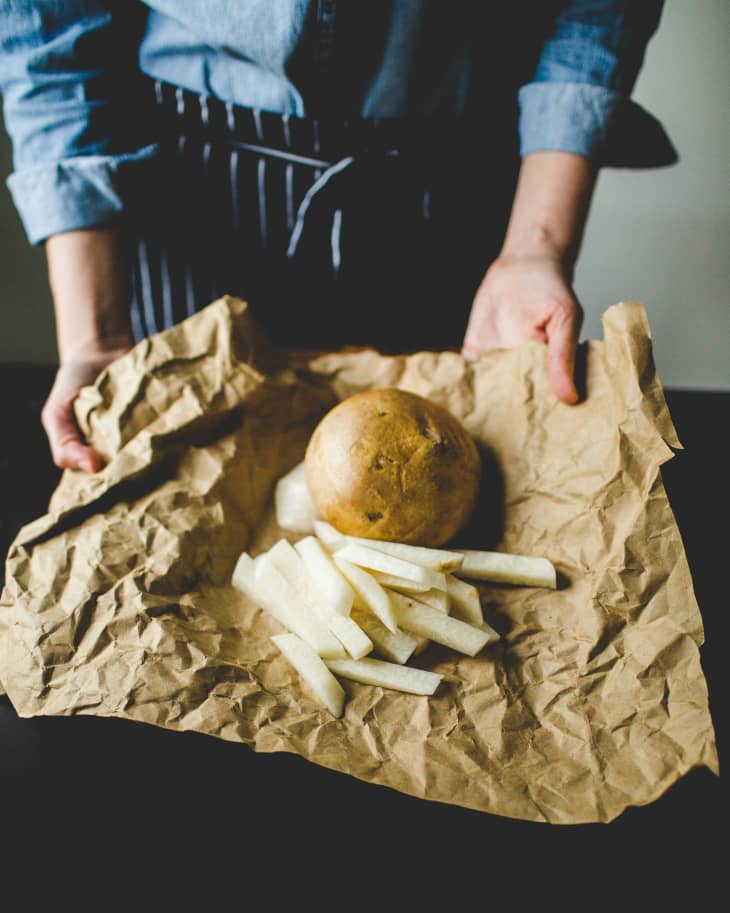Jicama Is Probably the Most Exciting Vegetable You’re Not Eating
Jicama can be intimidating. If you haven’t been formally introduced to the whole vegetable, you probably don’t know what you are looking for. And once you do know the tuber’s form, they can be quite large, with bark-like skin — perhaps even a little ominous. It’s easy to forget how juicy, crunchy, and downright exciting they are. I hear it all the time when customers bite into jicama. “Why don’t I eat jicama more?”
I’m here to help answer your jicama questions. Let’s figure this out.
What is jicama?
It’s a wonderfully juicy, sweet, and nutty tuber with a distinct crunch. It is most commonly enjoyed raw, but you can cook jicama, too. Its white flesh stays crisp when cooked briefly.
What does it taste like?
I recently heard jicama described perfectly as a savory apple. That’s exactly right. (I’ve been using this description ever since, and you can, too.)
Where can I find it?
You probably won’t find jicama at your farmers market, but you can certainly procure it at the supermarket; specialty produce shops; and Mexican, Latin American, and Asian markets.
Should I peel jicama? Do I just use a vegetable peeler?
Yes, you need to peel a jicama’s thick, papery skin, but please do not peel jicama skin with a vegetable peeler! A chef’s knife will give you much better (and safer) results.
Cut a thin slice from the top and bottom of the jicama to create a flat surface on each end. Rest the jicama on its broadest cut end. Working from top to bottom and following the curve of the jicama, slide your knife under the skin to peel it. You can use a vegetable peeler to peel any tough, fibrous underlying flesh that remains.
How do I cut jicama?
After peeling, place jicama on its widest cut end. Make vertical cuts, spaced evenly, moving from one side of the root to the other — this will produce thick slabs. Cut through the slabs to produce sticks. Cut across the sticks to produce a dice. You can also cut jicama in half or quarters, then shave thin slices on a mandoline. Use the thin slices as is, or cut through them to produce matchsticks.
Jicama flesh is so white — will it brown quickly?
Jicama actually doesn’t discolor like you think it would. You do not need to rub it with lemon or store it in acidulated water. You can use half of a root, store the other half in the fridge, and come back to it days later. (The cut end will be dry, so cut it away before you prepare it.)
Jicama tastes great raw, but what else do I do with it?
Jicama is known for its raw talent, but it can most certainly be cooked, too.
- First, know that a jicama stick can stand up to a carrot stick any day — excellent on its own, or with a dip or vinaigrette.
- Jicama makes an excellent salsa — a perfect match for a tortilla chip or to top a taco. Cut jicama into slim sticks, then dice it finely. Combine the jicama with corn or diced tomato, black beans, a little red onion or scallion, minced jalapeno, cilantro, and lime juice.
- Cut jicama into thin strips or matchsticks and make a slaw with shredded red cabbage, carrots, and avocado.
- Tuck jicama matchsticks into fresh spring rolls.
- Stir-fry jicama; its flesh stays crisp when cooked briefly, adding a refreshing crunch to any strir-fry. Try it with broccoli, garlic, ginger, scallions, and toasted sesame seeds or cashews.
What is your favorite way to eat jicama?
I love jicama chips! It can feel tedious to make, I’m not going to lie, but jicama chips are divine — crunchy, salty, and addictively sweet. Make them when you have a leftover half of a jicama and when you are working through a to-do list around the house.
How to Make Jicama Chips
Peel a 1-pound jicama in half lengthwise. Slice the jicama on a mandoline set to about 2mm. Spread the slices out over two to three parchment-lined, rimmed baking sheets to fit the jicama in single layers. Brush the jicama on both sides with a thin coating of olive oil and sprinkle with salt and freshly ground black pepper. Bake at 200°F, turning the jicama every 20 minutes or so, until crisp, 90 to 100 minutes.
